Writing About Gore
Vidal: 1951-Present
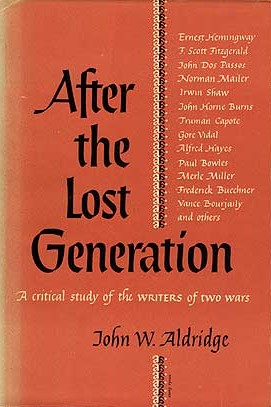 After the Lost Generation (1951)
After the Lost Generation (1951)
By John W. Aldridge
"One cannot speak of fiction without sooner or later speaking of values,"
writes John W. Aldridge, the noted literary critic, in his introduction to
After the Lost Generation: A critical study of the writers of two
wars. His book, seminal in its time, now feels rather dated because
of what Aldridge means by this assertion. And while he devotes only 14
pages to Vidal, his book offers the first critical evaluation of Vidal's
work, thus giving it a special place in Vidaliana.
Aldridge argues that the insistence of certain writers in exploring
homosexuality represents an immaturity and lack of values in their work.
That's not exactly a good place from which to evaluate Vidal's writing -
nor any writing, for that matter, if the critic's obvious homophobia so
colors his insight. In fact, Aldridge initially liked Vidal's first two
novels, Williwaw and In a Yellow Wood, when he wrote
about them contemporary to their publications. A few years later, in
After the Lost Generation - and after the appearance of The
City and the Pillar, in which Vidal essentially outed himself -
Aldridge's opinion of Vidal mysteriously changed.
In a five-page portion of his book, Aldridge suggests that
homosexuality may occur in so many novels of his time because it is "one
of the last remaining tragic types. His dilemma, like that of the Negro
and the Jew, provided a conflict which is easily presentable in fiction
and which can be made to symbolize the larger conflicts of modern man." Of
course, it never occurred to him that these novelists were simply writing
passionately about their own experience from a point of view couldn't
understand - or if it did, then the times forbade him to suggest it (or
tolerate it). He also says that "the homosexual experience is one of a
special kind, it can develop only in one direction, and it can never take
the place of the whole range of human experience which the writer must
know intimately if he is to be great."
Aldridge's displeasure with Vidal's writing seems to begin with his
second novel, In a Yellow Wood, the first with homosexual
characters. Naturally, he disliked (and misread) The City and the
Pillar, finally stating, "If Vidal showed signs in his previous work
of a weakening of his technical and dramatic power, he here shows the far
more disturbing signs of a spreading aridity of the soul." He called the
novel "purely a social document that was read because it had all the
qualities of lurid journalism and not because it showed the craft and
insight of an artist."
Aldridge concludes, at last, that "as [Vidal's characters] search for a
center of life, so he searches for a center of art." In order for Vidal's
work to achieve its goal, he argues, Vidal must discover "a value and a
morality for them and for himself."
Gore Vidal (1968)
By Ray Lewis White
Thorough, thoughtful and edifying, Professor White's critical study is the
first book-length treatment of Vidal's work. In his introduction, the
author confesses that such a historic literary undertaking "involves at
once a special pleasure and a special responsibility." His book moves in
an orderly fashion through Vidal's canon of the time, stopping with
Washington, D.C., just before Myra Breckinridge and its
manifestation of a startling new direction in Vidal's literature and
reputation.
"Gore Vidal has deserved a better hearing from literary critics than he
has received," White asserts, just before discussing Aldridge's reception
of Vidal a decade earlier. White, clearly an admirer of Vidal's writing
and point of view, discerns a range of Vidalian voices: the "literary
prince" of his prolific youth; the tradesman, who wrote for television and
magazines to support himself when his novels didn't sell; the voice that
expresses a "reasonable respect for homosexuality," and that makes the
point that "there should be no point, no pointed finger, and no
fascination at all"; and finally, "the voice of involvement to his age,"
that of a writer "involved in shaping his nation." White concludes: "Were
the author and his ideas more deeply valued in the United States, that
country would not need so desperately to hear his voices."
Interestingly, despite White's plea for society to accept homosexuality as
a matter of course, neither his chapter on Vidal's life, nor his two-page,
year-by-year account of the highlights of that life, make mention of
Howard Austen, who had been Vidal's companion since the early 1950s.
Fifteen years later, in his own Gore Vidal, Robert F. Kiernan
would discreetly correct the record.
The Apostate Angel: A Critical Study of Gore Vidal
(1974)
By Bernard F. Dick
In his smart - and smartly written - examination of Vidal's work,
Professor Dick eschews Vidalian biography in the early pages and replaces
it with some brief autobiography: He began reading Vidal while in college
in the mid-1950s, when "most college students who were eager to know what
was happening in contemporary literature pursued their interests without a
mentor." He became hooked on Vidal, and the introduction of his book
asserts: "All one can ask of a writer like Vidal is that he produce
something of value in each field he enters. I believe he has."
 So the stage is set for a generous and experienced reading of Vidal's work
through Burr, a good stopping point. Dick gives his chapters
amusing titles, like "A Portrait of the Artist as G.I. Joe," "Huck Honey
on the Potomac," "Manchild in the Media," "The Hieroglyphs of Time" and
"Myra of the Movies; Or, the Magnificent Androgyne." Unique among studies
of Vidal's work, he addresses the juvenilia: poems and short stories
published when Vidal was a teen-ager, before he graduated from high school
and entered the Army. He even reprints three poems, using this passage of
his book to recount some brief biography, but always focusing on the
writing rather than the life.
So the stage is set for a generous and experienced reading of Vidal's work
through Burr, a good stopping point. Dick gives his chapters
amusing titles, like "A Portrait of the Artist as G.I. Joe," "Huck Honey
on the Potomac," "Manchild in the Media," "The Hieroglyphs of Time" and
"Myra of the Movies; Or, the Magnificent Androgyne." Unique among studies
of Vidal's work, he addresses the juvenilia: poems and short stories
published when Vidal was a teen-ager, before he graduated from high school
and entered the Army. He even reprints three poems, using this passage of
his book to recount some brief biography, but always focusing on the
writing rather than the life.
Among his astute and fluid readings of the work, Dick is not above the
occasional anecdote. "As a private person," he writes, "Vidal despises the
curious. He has been know to seat inquisitorial interviewers in a draft
and to accompany journalists seeking definitive proof of his sex life to a
bar where he would promptly leave them in their cups and stroll off with a
hooker." The tone of Dick's prose often adopts a demi-style similar to the
tone of the book he's discussing. Finally, his take on Vidal is just
right. "Vidal's allegiance to a literary past that exists, if anywhere, in
the English curriculum of the university, has seriously handicapped him,"
Dick concludes with critical admiration. "His vast reading, which must
surpass that of any of his American contemporaries, has made his standards
rigidly classical. . .Good writing is hard, gemlike prose that softens and
grows full when it becomes confessional."
Gore & Myra: A Book for Vidalophiles (1974)
By John Mitzel with Steven Abbott
Mitzel offers 35 pages of his "notes on Myra B." in this quirky little
book's predominant chapter, Patriarchy vs. "Pornography." The
notes position the indomitable (to say the least!) Myra as a Nietzchian
übermensch who "has power as her goal and lets nothing get in her
way. . . She's the Queen of Tomorrow, who'll pull a knife on you out from
under her Priscilla of Boston gown."
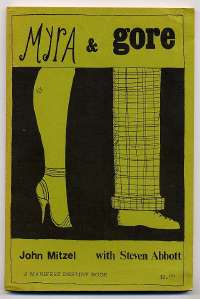 Camp aside, Mitzel's musings give a breezy reading to Myra through the
perspectives of feminism, sexual politics and emerging queer theory. No
section of his rapid-fire notes is longer than a page, and most are just a
paragraph or two, with the sections separate by asterisks. It ends with a
two-page coda, "Myra and Judy: A Terminal Thought," in which Mitzel uses
Judy Garland, Dorothy Gale and The Wizard of Oz to allow Judy to
teach Myra some lessons, and vice versa.
Camp aside, Mitzel's musings give a breezy reading to Myra through the
perspectives of feminism, sexual politics and emerging queer theory. No
section of his rapid-fire notes is longer than a page, and most are just a
paragraph or two, with the sections separate by asterisks. It ends with a
two-page coda, "Myra and Judy: A Terminal Thought," in which Mitzel uses
Judy Garland, Dorothy Gale and The Wizard of Oz to allow Judy to
teach Myra some lessons, and vice versa.
Next in the book comes "Three Carols for Myra Breckinridge," which are
poems penned by John Wieners, followed by Don Meuse's black-and-white
drawing of Vidal, and finally, a 40-page interview with Vidal, conducted
by Mitzel and Abbott, and originally printed in the magazine Fag
Rag. Much of the interview, which took place in Boston in November
1973, concerns sex and sexuality, although of course, politics, history,
culture and a little literature make an appearance. During the interview,
Vidal even compliments a reading of Myra Breckinridge that
appeared in Fag Rag without realizing that Mitzel wrote it.
Gore Vidal: A Primary and Secondary Bibliography
(1978)
By Robert J. Stanton
This hard-to-find resource is the first book-length bibliography of
Vidal's canon (a second one, by a different author, was published in
2007). Stanton provides detailed information on all of Vidal's book in
English and in translation through 1978, along with myriad citations of
major magazine and newspaper articles by and about Vidal. His 13-page
introduction walks through Vidal's novels and plays, offering some
analysis and critique.
Two years later, Stanton served as co-editor (with Vidal) of Views
from a Window: Conversations with Gore Vidal, an intriguing book that
brings together scores of interviews that Vidal gave to a wide range of
publications. Stanton blends the comments from various interviews and
arranges them by subject matter. The dust jacket of that book promises a
forthcoming critical study by Stanton of Vidal's work. However, no such
ever book materialized.
Gore Vidal or a Vision from a Particular Position
(1982)
By Stephen Macaulay
Not everyone who has published on Vidal appreciates his work. This little
anti-Vidalian tract was issued in November 1982 as Vol. 7, No. 6 of
The Rockford Papers, a series of monographs from the
ultra-conservative Rockford Institute of Rockford, Ill. In his 32-page
essay, Macaulay dissects and decimates Vidal's liberal agenda by
pretending to evaluate and criticize his fiction. The brief introduction,
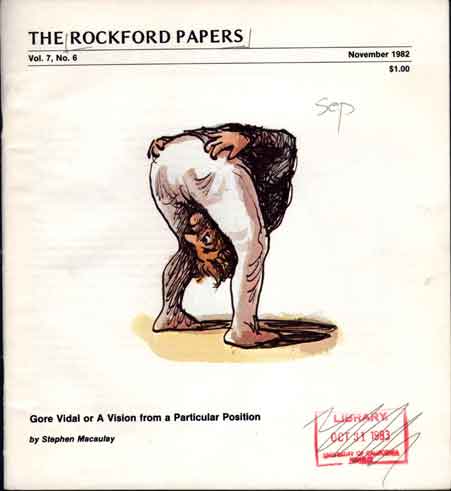 by editor Leopold Tyrmand, says that Vidal's work "has a peculiar and
repelling shallowness. . .that he is skilled at passing off as
meaningfulness," and the first three pages of Macaulay's essay offer a
smug "allusive" biography of Vidal's early life, referring to him only as
"Eugene," his middle name. Then Macaulay launches into the work itself,
asserting that Vidal "thinks he is the only one left among the Barbarian
Americans who still reads anything of a more taxing nature than TV
Guide."
by editor Leopold Tyrmand, says that Vidal's work "has a peculiar and
repelling shallowness. . .that he is skilled at passing off as
meaningfulness," and the first three pages of Macaulay's essay offer a
smug "allusive" biography of Vidal's early life, referring to him only as
"Eugene," his middle name. Then Macaulay launches into the work itself,
asserting that Vidal "thinks he is the only one left among the Barbarian
Americans who still reads anything of a more taxing nature than TV
Guide."
Typical of a reactionary conservative, Macaulay rails against Vidal for
railing against society. He accuses "Vidal and his partisans" of
constructing a sinister syllogism: "These novels are disturbing;
literature is disturbing; therefore, these novels are literature." Then,
echoing Aldridge 30 years before him, he asserts "that affirmation of
rudimentary humanness is also a part of the definition. [Vidal] chooses
to affirm venom and vice and what others may call filth - he sees them all
as the core of humanity. He consequently creates a world so that he can
destroy everyone in it. It all ends in the terminal negation: evil is
proclaimed as virtue and worshipped through ultimate debasement."
This, of course, is not what Vidal does as he explores the ways in which
people of power behave and the consequences of their behavior on society.
But Macaulay, again like Aldridge, is clearly more disturbed by Vidal's
politics than his literature, even if he refuses to admit it.
Gore Vidal (1983)
By Robert F. Kiernan
A professor at Manhattan College, Kiernan continued the work done by White
(1968) and Dick (1974) in their critical studies of Vidal. This book gets
as far as Creation, and Kiernan's opening year-by-year chronology
of Vidal's life notes that Vidal was, in 1981, on the verge of announcing
his candidacy for the U.S. Senate in California. Kiernan's entry for 1951
reads: "Lectures widely. Completes The Judgment of Paris. Begins
to live with Howard Austen." This is something that White could not bring
himself to mention in the more conservative literary circle of the 1960s.
Kiernan's study adds nothing monumentally new to the literature of
interpreting Vidal, whom he affectionately calls a "patrician hauteur."
His book opens with a critical biography, then goes on to discuss the
novels in groups, such as: the early successes (Williwaw and
The City and the Pillar), the ancient world, the American
trilogy, the Breckinridge novels, the essays, and the minor works (smaller
early novels, including Messiah, the Edgar Box mysteries and the
short story collection A Thirsty Evil).
Kiernan begins by discussing the several Vidalian manners: patrician
("cool, elegant, and somewhat haughty"); outré, ("witty, risqué,
obstreperous"); and intellectual ("epigrammatic, iconoclastic, and
cheerless"). "These manners and others that are shadings or combinations
of them are carried off with aplomb by Vidal both in his life and in his
writing," Kiernan writes. "But they are indubitably manners,
stylizations of the self that conceal as much of the man as they reveal."
The notion of Vidal's many voices winnows through Kiernan's book, until
his summation asserts, "Because Vidal is a writer with many voices, his
career seems a history of elaborate feints and passes." He calls Vidal a
farceur for whom "insouciance and insolence regularly join forces
in his rhetoric." But he's careful to point out that noting Vidal's
limitations "does not constitute an attack." He concludes: "The great
charm of Vidal's writing is its auctorial audacity. . .The Vidalian
persona, con brio, is the ultimate achievement of Vidal's art."
Gore Vidal: Writer Against the Grain (1992)
Edited by Jay Parini
Jay Parini's friendship with Vidal began in Italy in the 1980s, and for a
time, he was Vidal's literary executor. In this collection of 20 essays
and an interview (which he conducted himself), Parini has assembled a
valuable anthology.
 Parini's diverse book reprints chapters from the book-length studies by
White, Dick and Kiernan. Italo Calvino pens a salutation, commending Vidal
on his knowledge of and affection for Italy. Heather Neilson, an
Australian scholar who wrote a doctoral dissertation on Vidal, discusses
Messiah, as does the journalist/teacher Alan Cheuse. Stephen
Spender reflects on Gore Vidal: Private Eye, Louis Auchincloss on
Babylon Revisited (about the novel Hollywood), and
Harold Bloom discusses the big historical novel Lincoln.
Parini's diverse book reprints chapters from the book-length studies by
White, Dick and Kiernan. Italo Calvino pens a salutation, commending Vidal
on his knowledge of and affection for Italy. Heather Neilson, an
Australian scholar who wrote a doctoral dissertation on Vidal, discusses
Messiah, as does the journalist/teacher Alan Cheuse. Stephen
Spender reflects on Gore Vidal: Private Eye, Louis Auchincloss on
Babylon Revisited (about the novel Hollywood), and
Harold Bloom discusses the big historical novel Lincoln.
Together these essays are a mix of pure scholarship and intimate
reflection (from friends like Calvino and Auchincloss). "So what's going
on here?" Parini asks in his introductory essay. "Is Vidal a rather
old-fashioned realist? Is he anti-modern? Why has this postmodern
prototype been put on the shelf before he has, indeed, been taken off the
shelf?" Parini goes on to suggest reasons for this circumstance: Vidal's
unusually high productivity, his diverse canon, his insider approach to
his subject matter, and a "mandarin tone [that] relates not only to the
sense of the world as a fait accompli" but that "exists in every aspect of
the actual content." In short, Parini says, Vidal's way of writing, in
most of his fiction and all of his essays, leaves little room for the
reader to discern a subtext. "The tone is the essays," he
asserts. "It gives them their wonderfully acerbic edge and their
vitality." And while his best essays "somehow invite the reader to
participate in the 'knowingness' of it all," Parini recognizes that some
critics "recoil from this typically Vidalian stance."
Gore Vidal - L'iconoclaste (1997)
By Nicole Bensoussan
This is one of only two book-length study of Vidal's work written in a
language other than English (and, so far, not translated). The author is
French, and in her book, published by a university press, she studies the
political, religious and sociological undercurrents of Vidal's fiction and
nonfiction. Her chapter titles include "A Decadent Society,"
"Homosexuality and Alienation," "The Founding Father" and "Culture and
Religion." Her book focuses mostly on Vidal's work from the 1960s forward,
although she does spend eight pages discussing Messiah. She
concludes that despite the implacable irony and black humor of his work,
Vidal has a streak of Puritanism that seeks to expose the ills and
stupidity of society in an effort to edify Americans and save them from
deterioration.
Gore Vidal - A Critical Companion (1997)
By Susan Baker and Curtis S. Gibson
In their eclectic book, Professor Baker and her husband, "a nonacademic
enthusiast of Gore Vidal's work," parse Vidal's canon wearing a variety of
scholarly robes. By adopting different analytical postures for different
books, they give us new historicist readings of Julian and
Kalki; feminist readings of Burr, Lincoln and
Myra Breckinridge; deconstructive readings of Duluth,
Live from Golgotha and Creation; Marxist readings of
Empire and 1876; a psychoanalytic reading of
Hollywood; and an intertextual reading of Washington,
D.C.
The result is something like a survey course in literary analysis applied
to the work of one author, with each chapter written for the uninitiated:
The authors describe the plot and character development of each book
before launching into their analyses, thus you needn't have read the books
to follow the discussions. There's a biographical sketch up front, and
even a chapter that breezes through the early novels. Their work is
comprehensive and obviously admiring, making connections between the books
and with their influences rooted in Vidal's reading.
Gore Vidal: A Biography (1999)
By Fred Kaplan
English professor Kaplan's bountiful biography of Vidal is unsparing in
its detail and thorough in its evaluation of a writer whom one might call
- tongue firmly planted in cheek - the Forrest Gump of 20th Century
culture: Either directly or through small degrees of separation, Vidal
seems to have intersected the lives of virtually every literary,
political and cultural figure since his birth in 1925 at the U.S.
Military Academy at West Point. Kaplan writes about this busy life
journalistically in the broadest sense of the term: His biography is, on
the one hand, a detailed journal of Vidal's life, and on the other, a
rollicking good story, with vividly described characters and a climax to
virtually every chapter.
 Vidal emerges as a successful, fortunate and maybe even rather ordinary
man of letters.
He wanted to be a writer, and so he worked diligently at it, winning
recognition in every medium he attempted. He did not destroy his life and
work with alcohol, ego, greed, anger, bitterness or depression, like so
many other writers one could name. He engaged life, but always somehow as
an outsider, which allowed him clearer eyes to write about it.
Vidal emerges as a successful, fortunate and maybe even rather ordinary
man of letters.
He wanted to be a writer, and so he worked diligently at it, winning
recognition in every medium he attempted. He did not destroy his life and
work with alcohol, ego, greed, anger, bitterness or depression, like so
many other writers one could name. He engaged life, but always somehow as
an outsider, which allowed him clearer eyes to write about it.
He has, in short, lived a vividly public life of the mind, expressed in a
voluminous body of work. As for the inner life, Vidal has always largely
kept such feelings to himself, and Kaplan doesn't fell compelled to drag
anything of him. From time to time it's evident in the biography -
carefully guarded, cautiously revealed, and still somewhat of a mystery.
Kaplan writes elegantly, presenting his metaphors with precision, and
summarizing each of his panoply of characters with shrewd analyses. For
the most part he treats Vidal's novels and plays as incidents in the life,
incorporating their plots and meanings as a part of the ongoing narrative,
not bothering at any length to parse the work, which is the realm of other
projects.
The Fiction of Gore Vidal and E.L. Doctorow (2002)
By Stephen Harris
In his somewhat unusual pairing, Harris presents "a close study of the
relationship between the individual and history - between a particularly
American idea of self and how this is experienced in relation to the
broader flow of events and time that shape human experience." The author
is Australian, and at the time of his book's publication, he taught
American literature, Australian literature and creative nonfiction at a
university in New Zealand. He now teaches at the University of New England
in New South Wales and is at work on Gore Vidal's Historical
Novels and the Shaping of American Political Consciousness, which
Mellen Press published in 2005.
Focusing, of course, on Vidal's historical novels - mostly the American
Chronicles, with references to Julian and Creation
- Harris revolves his book around the well-accepted assertion that "the
opposition between the individual and society attains a thematic
prominence" in American literature that is "dramatized as an antagonism
between the private subject and society: it is against the latter that the
individual offers resistance, performing self-perserving or self-defining
acts of rebellion, whether through escape, confrontation or rejection." He
then spends some time discussing this strain of American literature before
turning to his authors - Vidal first, then Doctorow. By "working with the
'disagreed- as well as agreed-upon facts," Harris writes, Vidal
"signals the desire to engage, critically and interrogatively, with
received accounts of the past - to use fictionalized history as a
counter-version through which we are prompted to actively re-view
history."
Vidal's work, he argues, shows how "the historical fact of power. . .can
so readily gather in and around an individual," and by "resurrecting"
Aaron Burr as a "revisionist mouthpiece on American history, Vidal not
only finds the ideal voice for his own skeptical views on what is said to
have happened and therefore on what America so often wants to believe
happened, but he also finds a figure who dramatizes, in a thoroughly
ironic manner, the fact that the individual can influence history - that
(to use his metaphor) the stage is always set for the appearance of the
Caesarian character in whom history moves."
Homosexuality in the Work of Gore Vidal (2002)
By Jörg Behrendt
Guess what this book is about? This interesting scholarly work,
written in
English by a German, and published by LIT Verlag of Hamburg, is a thorough
accounting of Vidal's homosexual-themed literature and his definitions of
homosexuality, copiously footnoted and with a lavish bibliography (36
pages) of works cited. In that regard, it is clearly the most exhaustive
piece of scholarship yet written about Vidal, although the author does not
entirely agree with Vidal's sociology.
Behrendt begins with a brief look at Vidal's public image and critical
reception. He then defines some key terms - "camp," "homophobia,"
"homosexual," "minority" - before offering a biographical sketch of
Vidal's life and books. Early in his story, Behrendt state that "Vidal's
playing with autobiographic details will become an important aspect when
evaluating the sexual identities expressed in his work.," although he
agrees with Vidal that is it not necessary to know whether
details of an author's work are taken from his life.
The bulk of Behrendt's book then reads the novels and essays to discern
"Vidal's Conception of Homosexuality," which "stands in opposition to much
of today's writing about homosexuality, which usually rather stresses the
positive aspects of Gay identities." Vidal, of course, attaches neither a
positive nor a negative to sexual orientation - to him, it merely exists
- and he believes that there is no such thing as a homosexual person, but
rather merely homosexual acts. Gently troubled by this view, Behrendt
notes: "Contrary to Vidal, many Gays find comfort within a Gay identity
and a Gay community." He then spends several pages discussing seminal
works of homosexual-themed literature, and he concludes about his titular
subject: "Vidal's conception of homosexuality does not always hold
together, and his novels do not in all points reflect his nonfictional
comments on homosexuality. However, at a time when anti-Gay discrimination
is on the rise again, Vidal's conviction of the fundamental equality of
homosexuals and heterosexuals, the naturalness of all stages of the sexual
continuum, is worth being reconsidered."
Gore Vidal's America (2005)
By Dennis Altman
Altman's enjoyable book - published in October 2005 by Polity Press, to
coincide with Vidal's 80th birthday - isn't largely
original scholarship on Vidal but rather a piece of research and
journalism that collects insights on several threads (i.e. themes) of
Vidal's life and work: his ideas about American imperialism; his ideas
about human sexuality; his ideas about the role of religion in society;
and so forth. He also discusses Vidal's lack of interest in writing
sociological or psychological novels. Although Altman presents his
material well, people already familiar with Vidal's work and the
scholarship on it will probably not come away from Gore Vidal's
America having a deeper understanding of Vidal's role as a
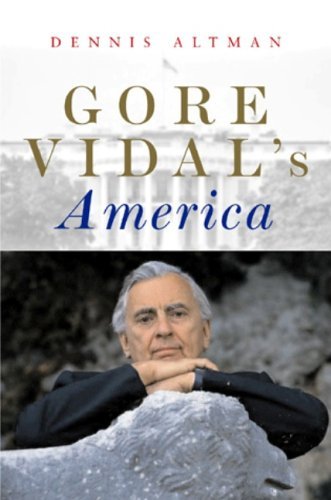 significant public figure, which Altman asserts early on is his goal.
Altman says he seeks to "demonstrate how Vidal 'embodies' a particular
critique of American society and politics, and, as part of this, seeks to
subvert both the triumphalist view of American history and mainstream
assumptions of sex and gender." He documents Vidal's work in these areas
well. But in the end, Altman demonstrates that Vidal has always been an
outsider and an iconoclast, rather than an icon or a trend-setter.
significant public figure, which Altman asserts early on is his goal.
Altman says he seeks to "demonstrate how Vidal 'embodies' a particular
critique of American society and politics, and, as part of this, seeks to
subvert both the triumphalist view of American history and mainstream
assumptions of sex and gender." He documents Vidal's work in these areas
well. But in the end, Altman demonstrates that Vidal has always been an
outsider and an iconoclast, rather than an icon or a trend-setter.
The author, who teaches politics at La Trobe University in Australia, and
who has known Vidal casually for 30 years,
has written before on Vidal: A long while back, he wrote an account of
Vidal's first visit to Australia. That piece appears in his book "Coming
Out in the Seventies" and is summarized in his book "Defying Gravity."
Altman's new book doesn't attempt to read Vidal's work in light of
literary theory and criticism (psychoanalytic, deconstructive,
post-modern, etc.). That would be another enterprise altogether. Instead,
it cites popular criticism (i.e., literary essays in general
circulation magazines, rather than scholarly journals) but very little
scholarly criticism. In fact, the book to which Altman compares his study
of Vidal is a book by a journalist: Garry Wills. Altman states his central
thesis in terms of Wills' book on John Wayne. But there's an essential
difference: Wayne influenced popular culture, and he was an
iconic figure; Vidal, on the other hand, seems to contradict
society, and thus he's an iconoclastic figure.
Later in his book, Altman breezes over what might have been the zenith
of Vidal's life as a public figure: His debate, on national
television, against William F. Buckley at the 1968 political
conventions. This gets one paragraph of mention in the text when such an
encounter might have been the focus of an entire chapter exploring Vidal
as public figure. In fact, Altman fails to quote a famous assertions of
Vidal's that might cast a light on why he's not an influential
public figure: For half a century, Vidal has claimed that "the novel is
dead." By this, he means that the novelist is no longer looked
upon as a cynosure in American culture. Had Altman explored this
assertion, it might have led him to examine Vidal's diminished role as
"public figure" and his emergence as, some would say, our National
Conscience.
N.B. Altman discussed his book on Australian radio in January 2006.
You can listen
to the interview if you have Real Player on your computer. And in
November 2005, Altman and Vidal appeared together at a Los Angeles book
store to discuss the book. At this link, you can
hear the interview and read about the event.
How To Be an Intellectual in the Age of TV:
The Lessons of Gore Vidal (2005)
By Marcie Frank
This trenchant and acessible scholarly study uses as its foundation
Vidal's famous
aphorism, "Never pass up the opportunity to have sex or appear on
television." Frank, a professor of English at Concordia University in
Montreal, opens her book with this sentence and then looks closely at
everything in Vidal's canon - in print and on film - that helps to
extricate its meanings and nuances. Thus her lens is an ideological
portmanteau of Altman's book, released just weeks before hers by another
publisher, and of Behrendt's, published several years earlier, but which
she doesn't cite in her endnotes. [See above for summaries of these two
books.]
"Vidal's idiosyncratic combination of patrician hauteur and radical
politics," Frank writes, "proves as hard to assess within the framework of
the American political spectrum as his attitudes toward sexuality do in
the framework of current literary or cultural analysis." This states the
dilemma well, although she does overlook a simple explanation: Vidal is
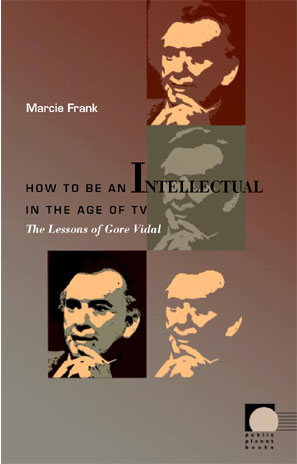 simply wrong about some things - for example, his long-standing assertion
that there is no such person as a "homosexual" (the word, Vidal argues, is
an adjective describing a behavior, not a noun describing an individual).
Her readings of Vidal's work find many illuminating links, although it's
quite odd that his 1954 novel Messiah gets only a passing mention
when it probably deserves an entire chapter. Begun in 1947 - well before
Marshall McLuhan published his most influential work on the role of media
in society - Messiah is the first text in which Vidal
explores medium-as-message.
simply wrong about some things - for example, his long-standing assertion
that there is no such person as a "homosexual" (the word, Vidal argues, is
an adjective describing a behavior, not a noun describing an individual).
Her readings of Vidal's work find many illuminating links, although it's
quite odd that his 1954 novel Messiah gets only a passing mention
when it probably deserves an entire chapter. Begun in 1947 - well before
Marshall McLuhan published his most influential work on the role of media
in society - Messiah is the first text in which Vidal
explores medium-as-message.
The value of Frank's book comes in how, within the context of her central
thesis, she unites the many tentacles of Vidal's body of work: his
American Chronicles, his "inventions," his nonfiction, his interest in
ancient history, and of course, his
appearances on television and in the movies. "The historical novels thus
provide the theory of his intellectual career," she writes, "while the
experimental novels provide the practice." She then traces this notion
through the writing and the life. Frank explores the movement away from
writers and toward university scholars as the honored intellectuals in our
culture. Vidal, she argues, "by supplementing the role of writer with
television," has managed to be both - and without shame or apology. And he
did so early in his career, when he recognized that the writer's role as
public intellectual was on the decline because of the media's rising
influence. Since then, in his fiction and nonfiction, he has explored
"the shift from print to screen modes of publicity," and he has
articulated a new harmony between "the pole of paranoia and romance,"
which Frank identifies as the two attitudes of traditional media
analysis.
"Vidal's public appeal," Frank writes, after a discussion of the American
Chronicles as "romance" novels, "rests on his ability to telecast and
write out of a position that does not cordon off serious literature from a
mass audience: rather, it brings Henry James and Jacqueline Susann
together. If Vidal maintains the status of exemplary American
writer-intellectual in the age of TV, it is because he has both exploited
the print-screen circuit in the genre of romance and found ways to
transmit his sexual politics on-screen."
Frank clearly recognizes that Vidal's two passions in life are politics
and human sexuality, the former because he grew up surrounded by it, and
the latter because he's a sexual outlaw himself. But he did not, as Frank
suggests, abandon the writing of "literary" novels merely because he
believed they were in decline. He abandoned them because, as he came to
better understand his own point of view, he naturally sought more
rewarding forms and mediums to express himself. Vidal once said that he
didn't expect readers in 1948 to associate the homosexuality of his
protagonist in The City and the Pillar with the author himself.
When they did, it forced him to re-evaluate the course of his life.
Vidal has certainly used the broadcast media to gain attention for his
political and cultural ideas, but he never actually used it to sell his
books. His novels Julian, Washington, D.C., Myra Breckinridge and
Burr became best-sellers on their own. His TV appearances in the
1960s through the 1980s largely followed the success of those
books, and many of his books along the way failed to attract readers
despite his notoriety. So it's something of an overstatement - or at
least, another matter altogether - when Frank asserts: "Vidal has
exploited electronic forms of publicity both to stay famous and to address
the divergence of the categories of literary author and
intellectual." All in all, Frank relies a bit too heavily on what
Vidal says about himself as she analyzes his literary and public lives.
She clearly seeks to reconstruct - rather than deconstruct - her subject.
Toward the end of her book, Frank neatly sums up and brings together its
threads. "Vidal's classicism consists of a universalizing understanding of
both sexuality and publicity accompanied by a strong sense of history that
registers changes in the status that has been accorded to each," she says.
"Against all expectations framed by the contemporary udnerstanding of TV,
Vidal is able to yoke classicism to TV, the vehicle through which his
politics (and sexual politics) frequently have been expressed." In other
words, Vidal is an orator, like an ancient Roman, and he uses both print
and moving pictures (film and TV) to orate on sex and politics, the two
subjects that most interest him (as they did his classical ancestors).
If Vidal has appeared so much on television, it's probably because, as
his aphorism implies, television is simply another form of instant
pleasure (and no doubt a stroke to his voluble ego). One doubts that his
sex life, the corollary to his broadcast life, did much to foster his
career. Quite the opposite, in fact, as Frank reminds us: The City and
the Pillar, so scandalous in its time, forced him to begin writing
pulp novels under pseudonyms and scripts for live television. And it's
certainly not true that "the pleasures of sex and appearing on TV are
interchangeable," as Frank writes. Vidal never said that, and one
hope that he's had far more of the former than the latter.
Gore Vidal's Historical Novels
and the Shaping of Political
American Consciousness (2005)
By Stephen Harris
In his 2002 book The Fiction of Gore Vidal and E.L. Doctorow,
Harris examined "the historical fact of power" as represented in Vidal's
historical novels. His new book, published by Edwin Mellen
Press, focuses on Vidal's works exclusively, taking a closer look
at how Vidal combines history and fiction.
A construção da memória da nação em José Saramago e
Gore Vidal (2006)
By Adriana Alves de Paula Martins
Like Vidal, the Portuguese writer José Saramago is a novelist, playwright
and essayist. And like Vidal, he looks at history in a way that mainstream
historians call subversive, searching beyond the recorded history. But
unlike Vidal he's won the Nobel Prize for literature (in 1998).
 In her critical study - published in Portuguese, and so far not
translated into English - Martins compares the historical novels of the
two authors. The web site of the book's publisher, Peter Lang, says
that the book explores different models of post-modern historical fiction,
particularly the historical fiction of Saramago and Vidal, looking at how
the works reconstruct the historical memory of their respective nations.
The book is one of only two critical studies of Vidal's work published in
a language other than English. The title means "the construction of the
history of the nation in José Saramago and Gore Vidal."
In her critical study - published in Portuguese, and so far not
translated into English - Martins compares the historical novels of the
two authors. The web site of the book's publisher, Peter Lang, says
that the book explores different models of post-modern historical fiction,
particularly the historical fiction of Saramago and Vidal, looking at how
the works reconstruct the historical memory of their respective nations.
The book is one of only two critical studies of Vidal's work published in
a language other than English. The title means "the construction of the
history of the nation in José Saramago and Gore Vidal."
"The postmodern experience reflects a moment of crisis in the modernity
project that is translated into a crisis in the representation of the
empirical world," Martins writes of her work. "In historical terms, this
crisis results in a process of revision and reassessment of the
interpretation of the historical phenomenon. In literary terms, [it]
translates into the search for new aesthetic codes [that] informs the two
main currents of postmodern literary production: experimental fiction and
historical fiction." Her book seeks to show "how Vidal's and Saramago's
novels reveal the structure of the 'building' of the American and
Portuguese national memories," and "and how these processes promote the
rereading and rewriting of the past." She also explores the extent to
which the novels hold any hope for "intervention and historical
transformation."
Martins has also published a few essays on Vidal's work in various
journals and anthologies in both English and Portuguese: "Quotation and
Memory in Gore Vidal's Burr and José Saramago's The History
of the Siege of Lisbon," in the book In Dialogue with José
Saramago: Essays in Comparative Literature (co-edited with Mark
Sabine), as part of the Manchester Spanish & Portuguese Series, No. 18
(2006), pages 163-175; "O Cinema Americano e a Mentira da Guerra em
Hollywood de Gore Vidal," in the journal Máthesis, issue
No. 15 (2006), pages 1-9; and "O Verso e o Reverso da Medalha em
Lincoln de Gore Vidal," in the journal Máthesis, issue
No. 14 (2005), pages 255-268.
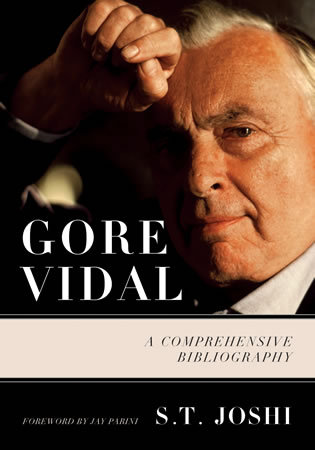 Gore Vidal: A Comprehensive Bibliography (2007)
Gore Vidal: A Comprehensive Bibliography (2007)
By S.T. Joshi
Robert Stanton's thorough bibliography of Vidal's work has been immensely
helpful in conducting Vidalian research since its publication in 1978. But
in the intervening years, Vidal has published many more books across
several genres, and he has seen his international popularity grow,
especially after the fall of the Soviet Union, which has allowed his work
to flourish in former communist countries.
S.T. Joshi - the author or editor of numerous books, including
Atheism: A Reader, which includes an essay by Vidal on American
fundamentalism - has updated the canon of research on Vidal with this new
and extensive bibliography. The book includes a foreword by Jay Parini,
Vidal's literary executor and himself the editor of a collection of
scholarly essays on Vidal.
Naturally, Joshi begins by listing all of Vidal's books in English
(U.S. and U.K.) along with a publication history that documents every
edition. For fiction, he briefly summarizes the plot; for essay
collections, he lists the contents of each book. Other sections in the
bibliography round up: articles and reviews by Vidal, briefly describing
the content; archival material at Harvard (the major repository) and other
locations; Vidal in the media; news items and encyclopedia listings about
Vidal and his family; interviews with Vidal; books and essays about Vidal;
and in a highly informative final section, major-media criticism and
reviews of Vidal's books, with concise summaries that excerpt many of the
reviews listed for each book. There are even brief sections listing web
sites and academic papers. A long introduction by the author walks the
reader through Vidal's personal and literary biography.
Joshi's section on foreign editions in his weakest. Although once again
greatly detailed - and certainly helpful to collectors - it overlooks
numerous editions, both older ones and more recent ones issued well before
Joshi's 2006 cutoff date. The section even fails to list three languages -
Korean, Slovak and Arabic - into which Vidal has been translated. Joshi
lists the Finnish edition Naiset kirjastossa ja muita kertomuksia
as a "translation of an unspecified work by Vidal." All it would have
taken to solve this mystery is a Finnish speaker to translate the title,
which means "The Ladies in the Library and Other Stories." This 1986 book
is, in fact, three stories selected from A Thirsty Evil, Vidal's
1956 collection of seven stories. The Finnish trilogy of stories was also
published in an English-language edition, which Joshi lists elsewhere,
incorrectly, as a reissue of the full seven-story 1956 collection.
No doubt a book this ambitious, involving so much research and minutiae,
was bound to have omissions and errors. It remains a valuable and very
interesting book, especially for its notations on the copious writing
about Vidal over the past half century.
Gore Vidal: A Bibliography, 1940-2008 (2009)
By Steven Abbott
Abbott began his association with Vidal in 1974, when he and John Mitzel
interviewed Vidal at length and published the interview in the magazine
Fag Rag and in the book Gore & Myra: A Book for
Vidalophiles (see above). Now, more than 35 years later, Abbott has
complied an exhaustively documented, two-volume bibliography of Vidal's
oeuvre. Abbott met with Vidal's agents and publishers during the
writing of the book, and he visited Vidal at his home in Ravello, Italy,
where he had access to Vidal's personal library. The book's publisher, Oak
Knoll Press, has a web page for the book that offers an excerpt, the table of
contents and a slide show of images.
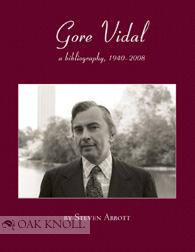 Volume one of the bibliography is a book illustrated with more than 500
black and white images of Vidal's book covers and title pages. Volume two
is a CD-ROM that presents color images of the covers of many of Vidal's
books. Inside the printed edition, Abbott does more than just list Vidal's
books, plays, screenplays, magazine articles, interviews, juvenilia,
contributions to other books and more. He describes many of these
publications in copious detail.
Volume one of the bibliography is a book illustrated with more than 500
black and white images of Vidal's book covers and title pages. Volume two
is a CD-ROM that presents color images of the covers of many of Vidal's
books. Inside the printed edition, Abbott does more than just list Vidal's
books, plays, screenplays, magazine articles, interviews, juvenilia,
contributions to other books and more. He describes many of these
publications in copious detail.
This is not a book that one sits down to read cover to cover. It's a
reference guide that will last for generations as an encyclopedia of
Vidal's writing and the forms in which it was delivered to the public.
Each entry in the A section, for example, which details English-language
editions, describes each book in near microscopic detail. Throughout the
years Vidal has revised and republished some of his books, and Abbott has
read the original and revised texts page by page, creating easy-to-follow
charts that document the changes word by word.
The section on foreign editions has more than 400 individual entries,
including citations for Vidal's writing that has been translated into
Braille. For the convenience of the reader, Abbott lists foreign editions
in two ways: language by language, for people researching all of Vidal's
books in a particular language; and title by title, for people researching
all of the translations of a particular book.
Abbott also includes a lengthy chronology of Vidal's life and work, and a
voluminous section on Vidal's writing in periodicals, his writing for
television and the movies, and writing about him in magazines and books.
It's a definitive work for literary scholars and Vidalophiles.
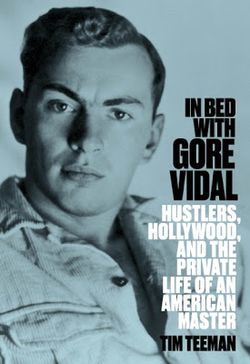 In Bed with Gore Vidal:
In Bed with Gore Vidal:
Hustlers, Hollywood, and the
Private World of an American Master (2013)
By Tim Teeman
Gore Vidal never referred to himself as "gay" and bristled at anyone who
did. He always asserted that all people are bisexual - some practicing,
some not. Of his tell-all book, due to be published in November 2013, Teeman
says, "Vidal's friends and family talk about not just the sex Vidal
had and with whom, but the roots of his complex attitude towards sexuality
and love which lay in a fractured upbringing, and why his refusal to be
defined was as personal as it was intellectual. He may have been
"post-gay" before his time, but Vidal was also of his time.when being
"gay" meant being effeminate, an outsider, without power. Vidal did not
identify with any of those positions and wasn't in thrall to the equality
movement. He had grown up around power - his much-loved grandfather was a
senator - and he coveted his relationship with John and Jackie Kennedy
(whom he was related to) before they fell out, he claimed because Bobby
Kennedy believed Vidal's sexuality could become a White House
embarrassment."
Political Animals: Gore Vidal on Power (2015)
By Heather Neilson
An Australian scholar and teacher, Neilson began writing about Vidal in
the 1980s while getting her doctorate at Oxford, and her essay on
Messiah, adapted from her dissertation, appears in the 1992
book
Gore Vidal: Writer Against the Grain, edited by Jay Parini (see
above). She has published numerous articles about Vidal's work throughout
the years, including "The Friendly Ghosts in Gore Vidal" (2011), "A
Theatre of Politics: History's Actors in Gore Vidal's Empire"
(2008), "In Epic Times: Gore Vidal's Creation
Reconsidered" (2004), "Jack's Ghost: Reappearances of John F. Kennedy
in the work of Gore Vidal and Norman Mailer" (1997) and "Live from
Golgotha: Gore Vidal's Second 'Fifth Gospel'" (1995).
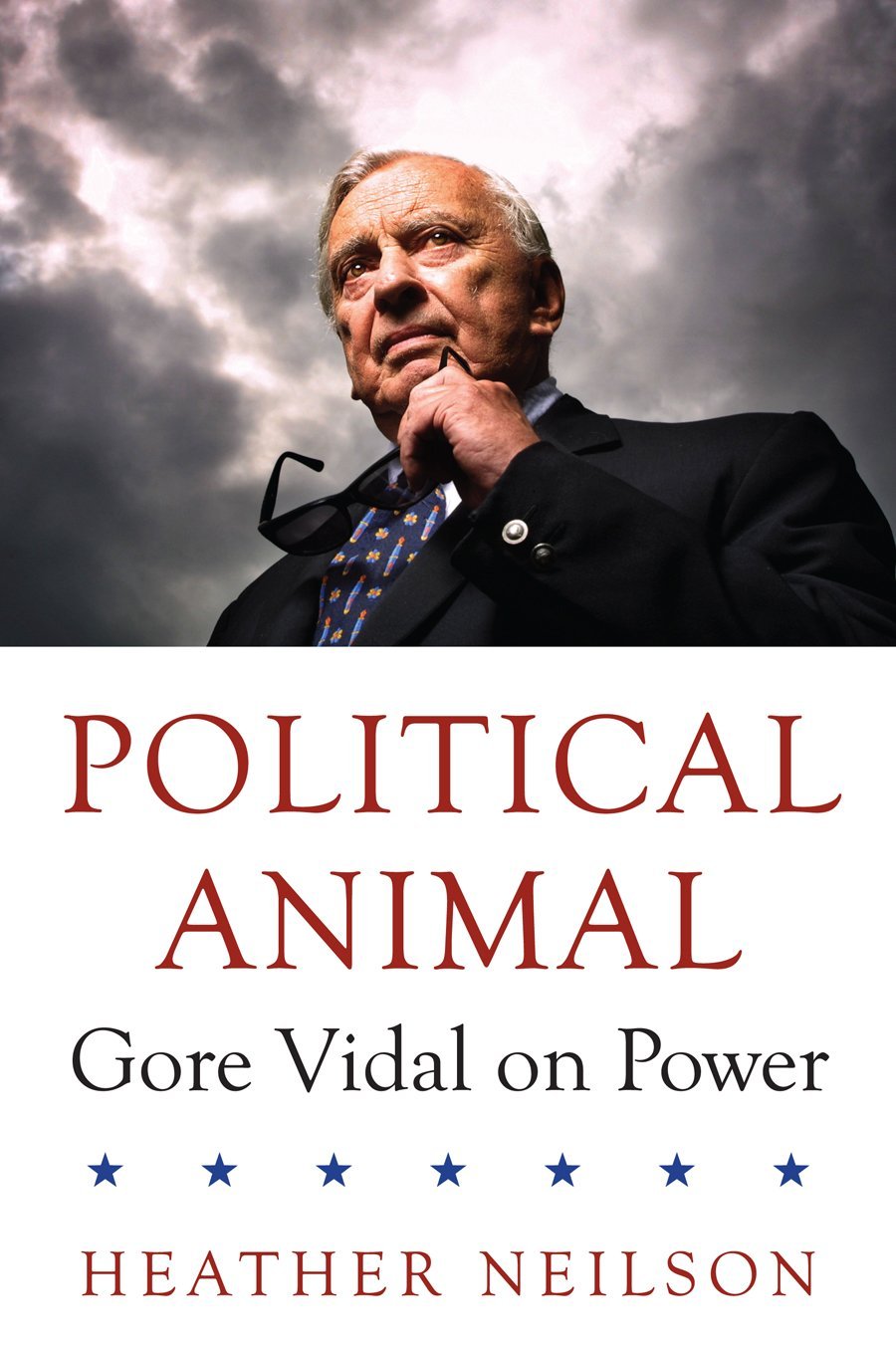
Neilson's book, her first on Vidal, will draw upon her dissertation and
her more recent thinking about his work as she looks at Vidal's
representations of leaders and historical figures (political, military and
religious), and how Vidal uses such people to explore the nature of power
structures. And because Vidal writes about the influence of media in
politics, so will her book.
Here's how the publisher describes it: "The late Gore Vidal occupied a
unique position within American letters. Born into a political family, he
ran for office several times, but was consistently critical of his
nation's political system and its leaders. A prolific writer in several
genres, Vidal was also widely known - particularly in the US - on the
basis of his frequent appearances in the various electronic media. This
ground-breaking work examines the centrality of the theme of power
throughout his writings. Political Animal: Gore Vidal on Power focuses
primarily, although not exclusively, on Vidal's historical fiction. In his
novels depicting American history, and those set in the ancient world,
Vidal evokes a world in which deliberately propagated falsehood
('disinformation') can become established as truth. The book engages with
Vidal's representations of political and religious leaders, and with his
deeply ambivalent fascination with the increasingly inescapable influence
of the media. It asserts that Vidal's oeuvre has a Shakespearean resonance
in its persistent obsession with the question of what constitutes
legitimate power and authority."
Sympathy for the Devil: Four Decades of Friendship with
Gore Vidal (2015)
By Michael Mewshaw
In this well-titled book, the writer - who has published journalism,
nonfiction, fiction and literary criticism - looks vividly and frankly at
the life of his generous, difficult, long-time friend. Filled with
anecdotes and tart observations, it's a vividly written memoir about
friendship and fame.
"Alcohol, massive amounts of it consumed over decades, did him
incalculable damage, raving his physical and psychological equilibrium,"
Mewshaw writes. "This, it might be argued, was his private business. But
because drinking undermined his work and his public persona, I believe
that this topic and his long-standing depression deserve discussion."
Whether it undermined his work - at least for most his life - is
certainly not settled personal history. But Vidal's alcoholism and
depression have rarely been approached, and learning about it here gives
new dimension to a man seen by so many as being haughty and aloof. Mewshaw
says his book is not (borrowing Joyce Carol Oates' term) a "pathography,"
which he describes as "a lurid post-mortem that dwells on an author's
deterioration." It's a more personal tale that takes a balanced and humane
look at his gifted friend.
Empire of Self: A Life of Gore Vidal (2015)
By Jay Parini
A teacher, novelist and scholar, Jay Parini of Middlebury College had been
friends with Vidal for 30 years before Vidal's death, and he was Vidal's
literary executor for a time. His biography draws on some memories of that
long friendship, but it's not an autobiography. In fact, Parini combines
observations about Vidal's novels and essays with his breezy retelling of
his life story. Shortly before the book's publication, Parini wrote a piece for the U.K. Guardian about his friend
and subject's often-contentious life.
 Return to the Gore Vidal
Thumbnails introduction
Return to the Gore Vidal
Thumbnails introduction
If you came right to this thumbnail page and don't see a frame on the
left, please visit The Gore Vidal
Index now or after you've enjoyed the thumbnails, which you can access
from the main index page. And please send me comments if you have a thought, a suggestion
or a link to add to the index.
©Copyright 2007 by
Harry Kloman
University of Pittsburgh
kloman@pitt.edu
 So the stage is set for a generous and experienced reading of Vidal's work
through Burr, a good stopping point. Dick gives his chapters
amusing titles, like "A Portrait of the Artist as G.I. Joe," "Huck Honey
on the Potomac," "Manchild in the Media," "The Hieroglyphs of Time" and
"Myra of the Movies; Or, the Magnificent Androgyne." Unique among studies
of Vidal's work, he addresses the juvenilia: poems and short stories
published when Vidal was a teen-ager, before he graduated from high school
and entered the Army. He even reprints three poems, using this passage of
his book to recount some brief biography, but always focusing on the
writing rather than the life.
So the stage is set for a generous and experienced reading of Vidal's work
through Burr, a good stopping point. Dick gives his chapters
amusing titles, like "A Portrait of the Artist as G.I. Joe," "Huck Honey
on the Potomac," "Manchild in the Media," "The Hieroglyphs of Time" and
"Myra of the Movies; Or, the Magnificent Androgyne." Unique among studies
of Vidal's work, he addresses the juvenilia: poems and short stories
published when Vidal was a teen-ager, before he graduated from high school
and entered the Army. He even reprints three poems, using this passage of
his book to recount some brief biography, but always focusing on the
writing rather than the life.












